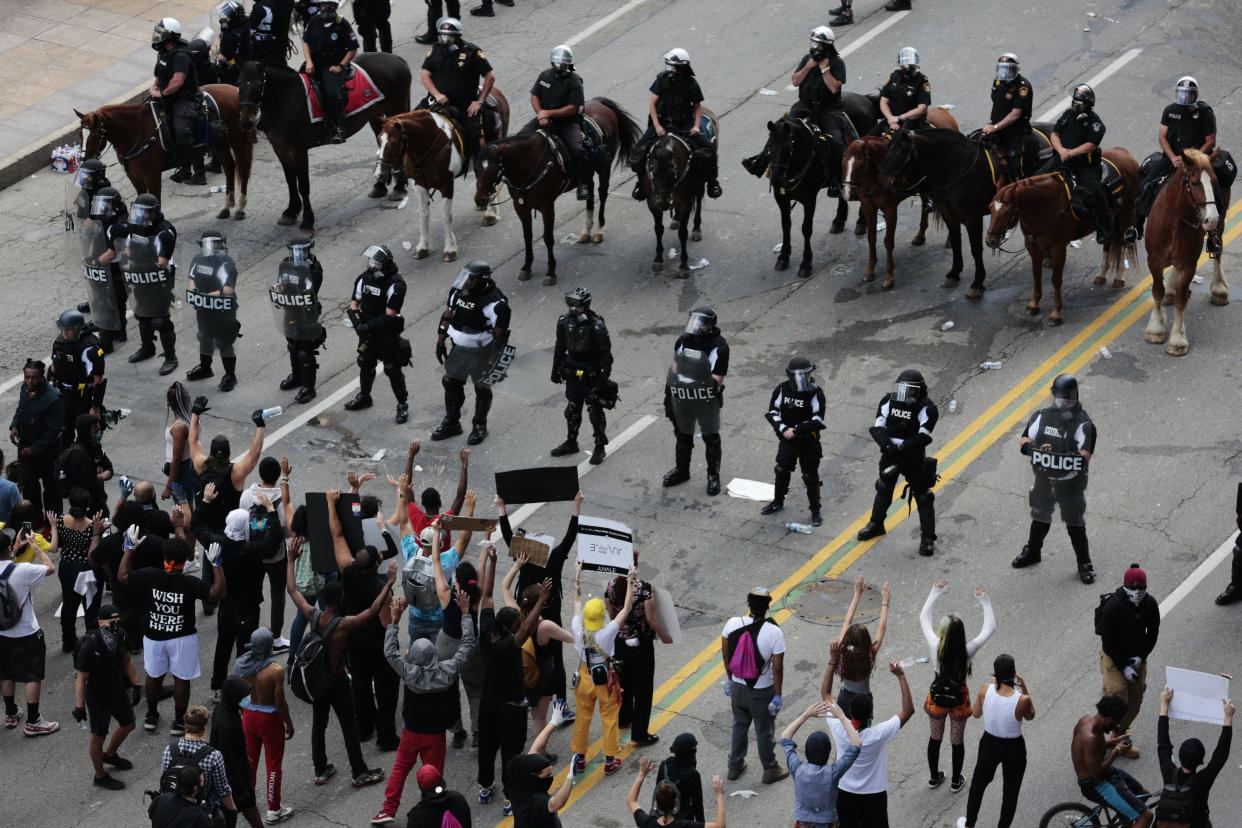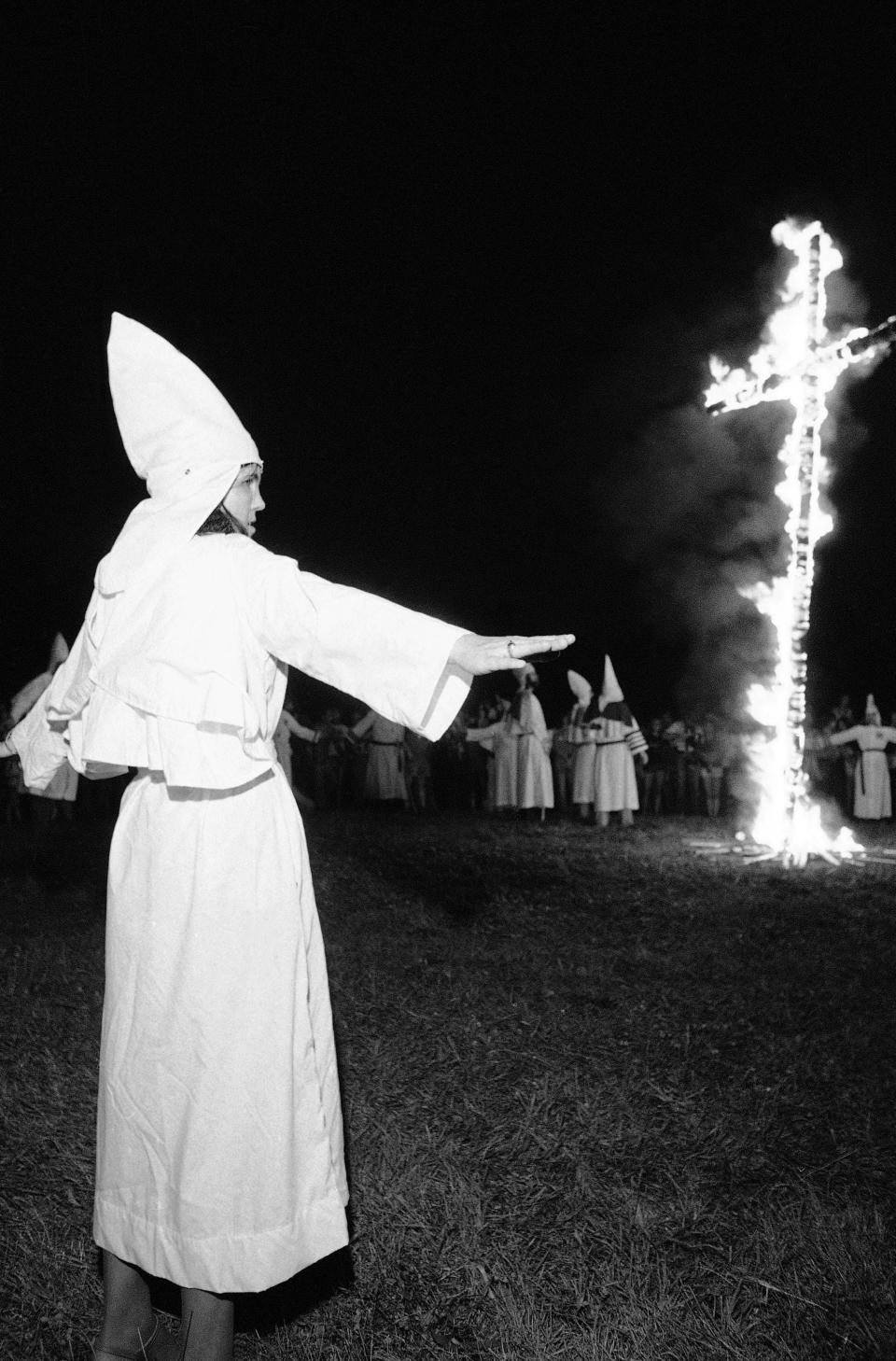Opinion: White nationalism is attacking racial equity. All who believe in liberty must act

Kevin McGruder is an associate professor of History at Antioch College.
The era that we are experiencing now in the United States, in which the 2020 nationwide protests for racial equality have been followed by a well-crafted campaign to misrepresent the vocabulary and the demands of the protesters, has many parallels to the distortions of the efforts to achieve racial equality during the Reconstruction era that followed the Civil War.
The dramatic post-Civil war progress of extending full citizenship rights to Black people was quickly characterized as a mistake. Contemporary efforts advocating racial equity have been inaccurately characterized as “divisive” and unfair to White Americans.
More: How highways destroyed Black neighborhoods in the '60s, as told by elders who were there
The Reconstruction period refers to the post-Civil War years between 1865 and 1877 when the federal government took uniquely aggressive efforts to repair the divided nation, and to establish and protect the full citizenship rights of Black Americans.
The Reconstruction Amendments to the Constitution were ratified during this period. The Thirteenth Amendment (1865) abolished slavery nationwide. The Fourteenth Amendment (1868) established citizenship rights for all people born in the United States, overturning the 1857 Dred Scott Supreme Court decision that asserted that Black people, enslaved or free, were not citizens.
More: Ohio Constitution allows slavery as a penalty for crime. Lawmakers want to change that
The Fifteenth Amendment (1870) gave Black men the vote. When the former Confederate states began to establish Black Codes placing severe restrictions on Black people in many southern states, the federal Reconstruction Act was enacted in 1867, after overriding President Andrew Johnson’s veto.
The new law required the division of the former Confederacy into five districts, each commanded by a Union Army general, and the deployment of federal troops in these districts to enforce the many provisions of the Reconstruction Law.
Opinion: Ohio lawmakers terrified of well-informed white children
Progress in the Reconstruction Era
The results were dramatic.
Black men voted in local, state and national elections for the first time.
Two Black men, Blanche Bruce and Hiram Revels, were elected to the U.S. Senate in Mississippi. Over a dozen Black men were elected to the U.S. Congress.
Hundreds of Black men were elected to state and local offices. Public school systems were established in southern states that had previously had none, benefitting White and Black children (although they were primarily racially segregated). The federal Freedman’s Bureau assisted Black people to acquire farmland and employment.
More: 5 politicians who were treated more unfairly than Trump
The swift backlash
![This historical marker outside of the Alachua County Administration Building in Gainesville acknowledges the lynchings of Blacks locally during the Reconstruction and Jim Crow eras. [Julia Cooper/The Gainesville Sun]](https://s.yimg.com/ny/api/res/1.2/UZU68RnlNgk36opA6lCYEQ--/YXBwaWQ9aGlnaGxhbmRlcjt3PTk2MDtoPTYyNA--/https://media.zenfs.com/en/the-columbus-dispatch/500e37cd8e9a771771fbf8f2897f7c3e)
As recounted in Eric Foner’s landmark 1988 book, "Reconstruction: America’s Unfinished Revolution, 1863-1877," the backlash by southerners to Reconstruction policies was immediate.
Calling themselves Redeemers, the term associated with the Christian concept of humanity being saved, redeemed, from sin through the actions of Jesus Christ, they worked to save white southerners from the “sin” of Reconstruction.
Their efforts gained critical momentum in the early 1870s when the North became preoccupied with an economic downturn.
Terroristic violence directed at southern Black people and their white allies, coupled with voting fraud and intimidation, were common southern resistance strategies.

The Ku Klux Klan which had been established in 1866 in Tennessee, even before the Reconstruction Act became law, was soon joined by other terror organizations such as the Knights of the White Camellia.
A major strategy of the Reconstruction backlash was the characterization of Black office holders as unqualified and corrupt.
White southerners were very receptive to both accusations since for centuries the institution of slavery had been justified by the belief that Black people were inferior and incapable of independent living. The Reconstruction institutions required federal, state, and local taxation and spending in states in which the planter class had previously maintained low tax rates and negligible services.
While some corruption exists in any government, the term “carpetbagger”— northerners seeking a quick dollar in the South, and “scalawag” — white southerners betraying their race by aligning with Black people to make a quick dollar, implied that corruption was inherent to Reconstruction and therefore a primary aim of those seeking racial equity.
Reconstruction's end, false narrative's beginning
The stalemated presidential election of 1876 pitting Rutherford B. Hayes, a Republican from Ohio, against Samuel Tilden, a Democrat of New York, led to a compromise in Congress in which it is claimed that in exchange for the presidency, Hayes agreed that federal troops would cease enforcement of the Reconstruction Law.
The end of Reconstruction was only the beginning of an effort to shape the retrospective narrative on Reconstruction as a corrupt mistake.
This narrative grew in the latter decades of the 1800s as racial segregation became the law of the South. It was accompanied by the dominant narrative in the southern press of Black men as rapists of white women.
This became the justification for hundreds of lynchings that took place, primarily in the south, over the succeeding decades.

In 1915 D.W. Griffith’s blockbuster film “Birth of a Nation,” with plot lines of Reconstruction corruption, Black inferiority and rapaciousness, and with the Ku Klux Klan riding to the rescue, is credited with inspiring the 1920s revival of the Klan.
Its new base was in Indiana, reflecting the large number of anti-Black advocates in the North.
In Reconstruction, Foner notes that by the twentieth century, the narrative of Reconstruction as a mistaken effort had attracted northern academics, such as historian William Dunning of Columbia University, whose interpretation of Reconstruction, in sympathy to the white southern perspective, influenced generations of historians.
Those historians influenced the general public.
“Decodifying” critical diversity, equity and inclusion

The recent distortions of the basic terms used by contemporary advocates for racial equality, such as critical race theory, anti-racism, woke, and diversity, equity and inclusion as terms of divisiveness rather than as concepts associated with the effort to achieve racial equality, is not happenstance.
A key figure in this well-organized campaign is Christopher Rufo, a journalist and conservative activist whose 2020 articles in City Journal, an online journal of the Manhattan Institute, disparaged federally supported DEI trainings and caught the attention of Donald Trump and some Republicans.
In a 2021 statement on Twitter, Rufo explained that his goal regarding the phrase critical race theory was “to have the public read something crazy in the newspaper and immediately think 'critical race theory.' We have decodified the term and will recodify it to annex the entire range of cultural constructions that are unpopular with Americans."
More: How critical race theory went from conservative battle cry to mainstream powder keg
When one considers the negative images that the mere mention of CRT now conjures up for many Americans, Rufo succeeded not only in “decodifying” critical race theory but also the phrase diversity, equity and inclusion.
The amendments prohibiting diversity, equity, and inclusion programs in the military, added recently to the federal Defense Bill now under review in Congress, make this clear.
Opinion: There is an 'uncomfortable' truth behind Critical Race Theory some want to silence
In 2022 Florida Gov. Ron DeSantis appointed Rufo to the Board of Trustees of Florida’s New College, the liberal arts college that DeSantis has promised to remake as an example of what can be done in the “state where woke goes to die.”
The goal is to have the public read something crazy in the newspaper and immediately think "critical race theory." We have decodified the term and will recodify it to annex the entire range of cultural constructions that are unpopular with Americans.
— Christopher F. Rufo ⚔️ (@realchrisrufo) March 15, 2021
Restoration of rights since Civil Rights
It took a century for the Civil Rights Movement — often called the Second Reconstruction — spurred by the nonviolent direct action of Martin Luther King’s Southern Christian Leadership Conference, and of the Student Nonviolent Coordinating Committee to reveal to the nation the damage done by the Jim Crow segregation that followed the Reconstruction era.
This new visibility led to grassroots mobilization resulting eventually in political support for important legislation such as the Civil Rights Act of 1964, the Voting Rights Act of 1965, and the Fair Housing Act of 1968.
The restoration of the rights of Black Americans began. The 2020 advocacy campaigns for racial equity were efforts to address the unfinished business of the Second Reconstruction.
The frog in the pan
We are in the midst of a backlash to these recent efforts. We might not recognize it because over the last decade we have witnessed a rise in white nationalism and a steady stream of overtly racists acts and statements from political leaders, celebrities and others that in other times would have been vigorously denounced.
YWCA: Ohio's chilling new pro-ignorance bill a threat that will drive off students
Like the proverbial frog in the pan of water with the heat slowly rising, as the level of overt racism in our culture has increased, many of us have become desensitized to it.
If those of us who are committed to our nation becoming a nation with liberty and justice for all don’t soon organize an aggressive, strategic response to the current backlash to racial equity demands, we could be entering a decades-long period in which our rights as they relate to racial equity will continue to be rolled back.
Like the frog in that pan of slowly rising, heated water, the result could be death — in this case of our democracy.
Kevin McGruder is an associate professor of History at Antioch College.

This article originally appeared on The Columbus Dispatch: We are in midst of racial equity backlash paralleling what happened after Reconstruction

